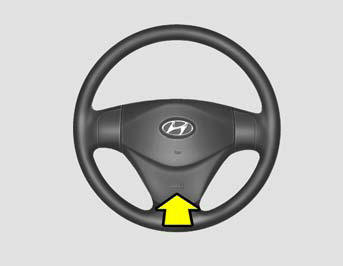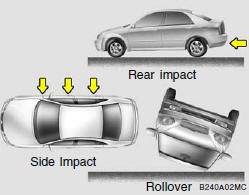Driver's and Passenger's Front Airbag

Your Hyundai is equipped with an advanced Supplemental Restraint (Airbag) System and lap/shoulder belts at both the driver and passenger seating positions. The indications of the system's presence are the letters "SRS AIRBAG" embossed on the airbag pad cover in the steering wheel and the passenger's side front panel pad above the glove box.
The Hyundai SRS consists of airbags installed under the pad covers in the center of the steering wheel and the passenger's side front panel above the glove box.
The purpose of the SRS is to provide the vehicle's driver and/or the front passenger with additional protection than that offered by the seat belt system alone in case of a frontal impact of sufficient severity. The SRS uses sensors to gather information about the driver's and front passenger's seat position, the driver's and front passenger's seat belt usage and impact severity.
The driver's and front passenger's seat track position sensors (If Installed), which are installed on the seat track, determine if the seats are fore or aft of a reference position. The seat belt buckle sensors determine if the driver and front passenger's seat belts are fastened. These sensors provide the ability to control the SRS deployment based on how close the driver's seat is to the steering wheel, how close the passenger's seat is to the instrument panel, whether or not the seat belts are fastened, and how severe the impact is.
The advanced SRS offers the ability to control the airbag inflation within two levels. A first stage level is provided for moderate-severity impacts. A second stage level is provided for more severe impacts.
According to the impact severity, seating position and seat belt usage, the SRSCM(SRS Control Module) controls the airbag inflation. Failure to properly wear seat belts can increase the risk or severity of injury in an accident.
Additionally, your Hyundai is equipped with an occupant classification system in the front passenger's seat. The occupant classification system detects the presence of a passenger in the front passenger's seat and will turn off the front passenger's airbag under certain conditions. For more detail, see "Occupant Classification System" later in this section.
WARNING:
If a seat track position sensor or an occupant classification system is not
working properly, the SRS airbag warning light
 on the instrument panel will illuminate
on the instrument panel will illuminate
because the SRS airbag warning light is connected with the seat track position sensor
and the occupant classification system. If the SRS airbag warning light does not
illuminate when the ignition key is turned to the "ON" position, remains illuminated
after approximately 6 seconds when the ignition key is turned to the "ON" position,
or if it illuminates while the vehicle is being driven, have an authorized Hyundai
dealer inspect the advanced SRS airbag system as soon as possible.
WARNING:
o Modification to the seat structure can adversely affect the seat track position sensor and cause the airbag to deploy at a different level than should be provided.
o Do not place any objects underneath the front seats as they could damage the seat track position sensor or interfere with the occupant classification system.
o Do not place any objects that may cause magnetic fields near the front seat. These may cause a malfunction of the seat track position sensor.
NOTE:
o Be sure to read information about the SRS on the labels provided on the topside of the sun visor.
o Advanced airbags are combined with pre-tensioner seat belts to help provide enhanced occupant protection in frontal crashes. Front airbags are not intended to deploy in collisions in which sufficient protection can be provided by the pre-tensioner seat belt.
o If you are considering modification of your vehicle due to a disability, please contact the Hyundai Customer Assistance Center at 1-800- 633-5151.
WARNING:
Always use seat belts and child restraints – every trip, every time, everyone! Airbags inflate with considerable force and in the blink of an eye. Seat belts help keep occupants in proper position to obtain maximum benefit from the airbag. Even with advanced airbags, improperly belted and unbelted occupants can be severely injured when the airbag inflates. Always follow the precautions about seat belts, airbags and occupant safety contained in this manual.
To reduce the chance of serious or fatal injuries and receive the maximum safety benefit from your restraint system: o Never place a child in any child or booster seat in the front seat (see child restraints 1-31).
o ABC – Always Buckle Children in the back seat. It is the safest place for children of any age to ride.
o Front and side impact airbags can injure occupants improperly positioned in the front seats.
WARNING:
o Move your seat as far back as practical from the front airbags, while still maintaining control of the vehicle.
o Never sit or lean unnecessarily close to the front or side airbags.
o Never lean against the door or center console – always sit in an upright position.
o Do not allow an adult passenger to ride in the front seat when the “Passenger Airbag OFF” indicator is illuminated, because the airbag will not deploy in the event of a moderate or severe frontal crash.
o Never place objects over or near any airbag module (front or side impact airbags), because these objects can injure passengers in a crash.
o Never place covers, blankets or aftermarket seat warmers on the passenger seat as these may interfere with the occupant classification system.
WARNING:
o Do not tamper or disconnect SRS wiring or other components. Injuries could result from inadvertent deployment or failure of the airbag to deploy in a crash.
o If the SRS airbag warning light (see pg 1-64) remains illuminated while the vehicle is being driven, have an authorized Hyundai dealer inspect the airbag system as soon as possible.
o Airbags can only be used once – have an authorized Hyundai dealer replace the airbag immediately after deployment.
o The SRS is designed to deploy the front airbags only when an impact is sufficiently severe and when the impact angle is within a range as measured from the forward longitudinal axis of the vehicle. The front airbags will not deploy in side, rear or rollover impacts. Additionally, the airbags will only deploy once. Seat belts must be worn at all times.
WARNING:

o Front airbags are not intended to deploy in side-impact, rear-impact or rollover crashes. In addition, front airbags will not deploy in frontal crashes below the deployment threshold.
o Move your seat as far back as practical from the front airbags, while still maintaining control of the vehicle. You and your passengers should never sit or lean unnecessarily close to the airbags. Improperly positioned drivers and passengers can be severely injured by inflating airbags.
WARNING:
o No objects should be placed over or near the airbag modules on the steering wheel, instrument panel, and the front passenger's panel above the glove box, because any such object could cause harm if the vehicle is in a crash severe enough to cause the airbags to deploy.
o If the airbags deploy, they must be replaced by an authorized Hyundai dealer. Deployed airbags WILL NOT inflate again and will provide no protection in subsequent collisions.
o Do not tamper with or disconnect SRS wiring or other components of the SRS system. Doing so could result in injury, due to accidental deployment of the airbags or by rendering the SRS inoperative.
o Even though your vehicle is equipped with the occupant classification system, do not install a child restraint system in the front passenger seat position. A child restraint system must never be placed in the front seat.
WARNING:
An infant or child could be severely injured or killed by an airbag deployment in case of an accident.
o Children younger than 13 years must always be properly restrained in the rear seat. Never allow children to ride in the front passenger seat. If a child over 13 must be seated in the front seat, he or she must be properly belted and the seat should be moved as far back as possible.
o For maximum safety protection in all types of crashes, all occupants including the driver should always wear their seat belts whether or not an airbag is also provided at their seating position to minimize the risk of severe injury or death in the event of a crash. Do not sit or lean unnecessarily close to the airbag while the vehicle is in motion.
WARNING:
o Sitting improperly or out of position can result in serious or fatal injury in a crash. All occupants should sit upright with the seat back in an upright position, centered on the seat cushion with their seat belt on, legs comfortably extended and their feet on the floor until the vehicle is parked and the ignition key is removed.
o The SRS airbag system must deploy very rapidly to provide protection in a crash. If an occupant is out of position because of not wearing a seat belt, the airbag may forcefully contact the occupant causing serious or fatal injuries.
See also:
Opening the trunk with the alarm armed (if equipped)
When the alarm is armed, the alarm will not sound if the trunk lid is opened
with the transmitter (or smart key). Once the trunk is opened and then closed, the
trunk will be locked automatically a ...
Windshield Wiper and Washer Switch
Windshield wiper/washer
Rear window wiper/washer (If Installed)
A : Wiper speed control
· MIST – Single wipe
· OFF – Off
· INT – Intermittent wipe
· LO – Low wiper speed
· HI – High wiper s ...
Towing service
recommend having it done by an authorized Hyundai dealer or a commercial tow-truck
service. Proper lifting and towing procedures are necessary to prevent damage to
the vehicle. The use of wheel ...


